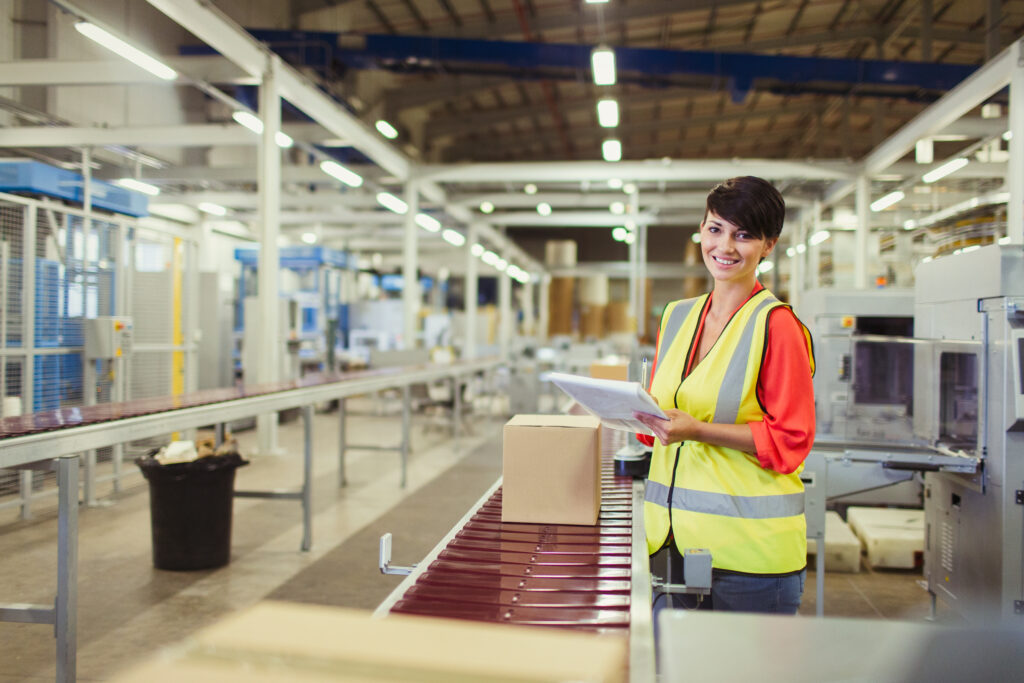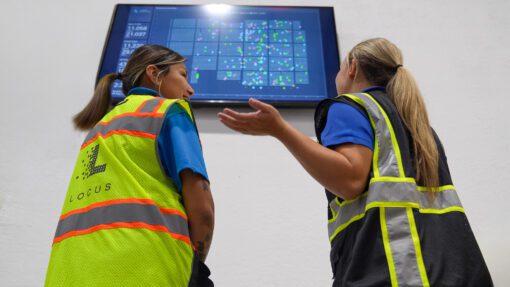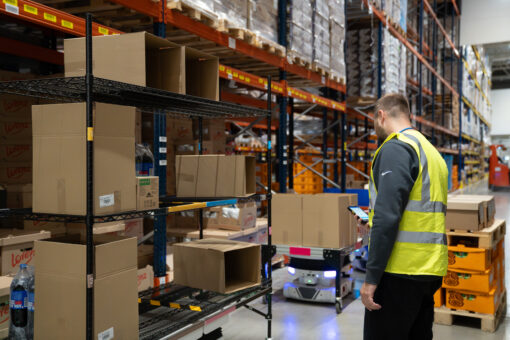WP: How to achieve 400 UPH with Locus Fast Pick
WP: How to achieve 400 UPH with Locus Fast Pick Download Now!
Breaking Down Top Warehouse Automation Myths
Mary Hart, Sr. Content Marketing Manager

Automation in the warehouse industry has been a hot topic for years, yet it remains shrouded in myths and misconceptions and I’ve covered a few of them in these blog posts. For many warehouse managers, the idea of automating processes conjures up concerns about complexity, cost, and the human factor. But these fears often stem from outdated or inaccurate information.
Today, warehouse automation is more accessible and beneficial than ever before. It's time to set the record straight and dispel the top myths that keep some warehouse operations from embracing the future. Let's break down these myths and explore the reality of what automation can do for your warehouse.
Myth 1: Warehouse Automation Will Replace Human Jobs
This is perhaps the most pervasive myth surrounding warehouse automation, and it’s rooted in a fear of robots taking over the workforce. In reality, automation isn’t about replacing associates — it’s about helping humans, making jobs easier, safer, and more productive.
Consider the experiences of Fleet Feet, a retailer that implemented autonomous mobile robots (AMRs) in their distribution center. Far from replacing their human workforce, Fleet Feet used automation to reduce the physical strain on their associates, allowing them to focus on higher-value tasks. AMRs took on the laborious and repetitive task of moving products around the warehouse, while employees were able to perform less physically taxing duties.
As a result, Fleet Feet’s associates reported higher job satisfaction. They appreciated being less tired at the end of the day and having more energy to enjoy personal activities outside of work. This myth, that automation takes jobs, ignores the actual reality: automation can enhance job quality, safety, and satisfaction. In fact, in most cases, it allows associates to accomplish more with less strain.
According to a study from the World Economic Forum, automation is projected to create 12 million more jobs than it displaces by 2025. The key is not to fear automation but to understand how it can complement and empower human workers, leading to a more productive and satisfied workforce.
Myth 2: Automation Has to Happen in All Facilities at Once
Many warehouse managers assume that automation is only suited for large, multinational operations with enormous budgets to automate their entire facilities. While it's true that large companies have implemented sophisticated automation systems across their organization, the technology can also be implemented in just one facility and then implemented across more locations.
Automation solutions, especially cloud-based systems with scalable robots, are designed with flexibility in mind. This means you can start by automating just one facility or one section of one facility and scale as your business grows. For example, alphabroder, a company that spans multiple distribution facilities across North America, didn’t automate all of their locations at once. Instead, they started with one facility, learned from the experience, and then expanded their automation solutions to other sites.
This approach allowed alphabroder to implement a sustainable automation strategy, gradually increasing their automation footprint without the need for a massive up-front investment. And they’re not alone.
For businesses of all sizes, the goal is the same: improve productivity, accuracy, and safety. Whether you're running a 50,000 square-foot operation or managing millions of square feet of warehouse space, automation can be tailored to fit your specific needs.
Myth 3: Automation Is Too Expensive
This myth often causes warehouse managers to hesitate when considering automation solutions. They assume that the upfront costs are prohibitive, or that it will take years to see a return on investment (ROI). While there are certainly some upfront costs associated with implementing automation, the long-term savings and efficiency gains often outweigh these initial expenses.
Consider MyPillow, which faced increasing complexity in its warehouse as its product line expanded to over 3,000 SKUs. The company initially questioned the cost of automating their operations, but after implementing 33 AMRs, they saw immediate improvements in efficiency and throughput. Their units per hour (UPH) increased from 119 to 210, while lines per hour (LPH) jumped to 150. In addition, their order cycle time improved by 50%.
The fewer picking errors and improved order fulfillment speed quickly added up, delivering a solid ROI in less time than anticipated. And because automation systems are scalable, companies can start small and expand over time, reducing the need for large, upfront capital investments.
A study by Deloitte found that 81% of companies using automation and AI-related technology saw a payback period of less than two years. By automating repetitive, time-consuming tasks, companies can reduce labor costs, minimize human error, and speed up processes — all of which directly impact your bottom line.
Myth 4: Automation Is Too Complex to Implement
One of the most common concerns about warehouse automation is that it’s too complicated to implement. Many warehouse managers envision months of downtime, complicated training processes, and massive disruptions to their operations. However, the reality is that modern automation solutions are designed to integrate seamlessly into existing workflows, with minimal disruption.
For example, when nGroup Performance Partners partnered with Locus Robotics to automate their putaway process, they were concerned about potential downtime during the implementation. However, the process went off without a hitch, and nGroup experienced no significant interruptions to their operations. After the robots were implemented, productivity increased by 130%.
Many modern automation platforms are also cloud-based, which means they don’t require heavy IT infrastructure investments. They also come with intuitive user interfaces that make training employees quick and easy. If you can use a smartphone, you can operate most warehouse robots.
To that end, Fleet Feet saw training times for new employees drop from a full week to just 30 to 45 minutes after implementing AMRs. Automation doesn’t need to be complex or disruptive. Instead, with the right technology partner and a clear implementation plan, you can integrate automation into your warehouse with minimal downtime and a smooth learning curve.
Myth 5: Automation Sacrifices Flexibility
Some warehouse managers worry that automation will lock them into rigid processes that can’t adapt to changing needs or unique situations. This myth stems from automation systems that relied on fixed infrastructure, like conveyor belts or automated storage and retrieval systems (AS/RS), which can be costly and inflexible.
But warehouse automation technologies like AMRs are designed with flexibility in mind. AMRs can be reprogrammed to handle different tasks or use cases or follow new routes in a matter of minutes. These warehouse automation solutions don’t require fixed or large-scale infrastructure, which means they can adapt to the ebb and flow of your business.
Ulta Beauty is a prime example of this. During the holiday season, they doubled the number of robots in their facility to handle the increased order volume. After the peak season, they scaled the number of robots back down. This flexibility allowed Ulta Beauty to remain agile, meeting fluctuating demand without having to permanently alter their warehouse infrastructure.
In fact, flexibility is one of the key advantages of modern warehouse automation. As customer demands change and your business grows, you can scale your automation systems up or down, ensuring your warehouse remains nimble and responsive to the market.
Myth 6: Automation is Only for Some Industries and Use Cases
Another common misconception is that automation only works for some warehousing industries, such as e-commerce or retail fulfillment centers. However, automation technologies are versatile and can be applied to a wide range of industries, from 3PLs and reverse logistics to manufacturers, healthcare, and specialty retailers.
For example, nGroup partnered with Locus Robotics to improve their reverse logistics operations. By integrating AMRs with their Optoro returns optimization platform, nGroup significantly enhanced productivity and accuracy in handling returned goods. This is a clear demonstration that automation can go beyond the traditional pick-and-pack operations to support complex, specialized workflows.
Busting the Myths Around Warehouse Automation
The myths surrounding warehouse automation often stem from outdated information or a misunderstanding of how modern automation technologies work. Today’s systems are designed to be scalable, flexible, and accessible to companies of all sizes. Automation isn’t here to replace associates — it’s here to empower them, making their jobs safer and more enjoyable.
Far from being too expensive or complex, warehouse automation can deliver rapid ROI, improve efficiency, and enhance worker satisfaction. And with flexible solutions that can adapt to your warehouse’s unique needs, there’s no reason to fear being locked into rigid processes.
If you're still hesitant about automation, it’s time to take a closer look at what modern solutions can offer. With the right partner, you can dispel the myths, embrace innovation, and drive your warehouse toward greater efficiency and success.
Want to learn more about how warehouse automation can benefit your operations? Let’s talk and you’ll see how Locus Robotics can help you implement scalable, flexible solutions that fit your needs.




